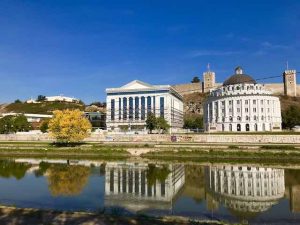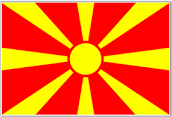
MACEDONIA
.
.
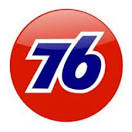
Macedonia – Trackchasing Country #76
Greetings from places on the way to Skopje, Macedonia. Click on the links below to read about and see the photos and video from my visit to this small but friendly eastern European nation of Macedonia……trackchasing country #76.
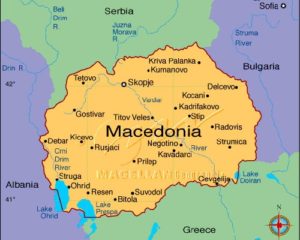
LIKE TO KNOW MORE ABOUT MACEDONIA – TRACKCHASING COUNTRY #76?
As a service to my readers, I always provide a top line background of each country I visit. If you’d like to learn a little more about the eastern European nation of Macedonia check out the “background” information I prepared for you. It appears at the bottom of this report. I have condensed this section so you can get a good “feel” for Macedonia. Most of the material comes from Wikipedia. We can trust them.
PRE-TRIP
Advance Preparation
THE RACE
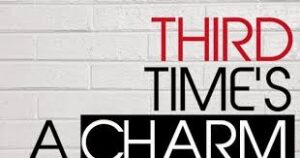
They say the third time is the charm. I hope that is true about seeing a race in Macedonia. Although I had never been to Macedonia this was my third attempt to see a race here.
Back on September 17, 2017, I was all set to see a race in Kicevo, Macedonia. I had purchased my airline ticket. I had made my hotel reservations. Initially, my plan was to travel to Macedonia on my own. Macedonia would be the single purpose of the trip.
I accepted an offer from my main Macedonian contact, Nikola Popevski, to catch a ride with his race team down to Kicevo. Kicevo is home to a permanent track located at a military training base. The track is about 110 kilometers from Skopje, the capital of the country. I was planning to have Skopje be my home base during this trip.
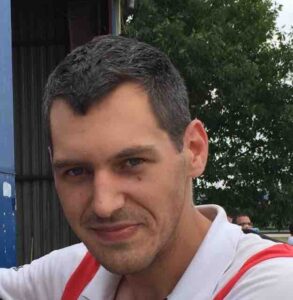
I told my good friend Boris Miljevic, who resides in Bosnia and Herzegovina about the trip. It was “only” a ten-hour drive from BiH to Macedonia for him. Boris was interested in joining me on this adventure. That would be great. He and I had trackchased last year in his home country as well as in Hungary.
Then about a week before the race, Nikola told me the race had been canceled. Ouch. Of course, it wasn’t Nikola’s fault. The race organizer had canceled the race when it was feared that an event in somewhat nearby Serbia might attract the Macedonia racers. Cancellation of this type had never happened before for any of my foreign track visits. I could still come to Macedonia I just would not be seeing a race there. I decided not to throw good money after bad and simply “ate” the cost of the ticket.
The canceled race was re-scheduled for a week later. I decided I would try to come to Macedonia again. I wouldn’t buy an airline ticket this time. I would fly standby. Then they canceled the second race! I was getting a little concerned about the reliability of this operation. I was told this second attempt to race was in conflict with local elections.
A lot of people would have given up on Macedonia by now. Not me. I believed in them. I believed in Nikola. Ultimately they did have that race in Kicevo. Unfortunately, I couldn’t go for the revised third date.
I had one more shot to see some racing in Macedonia in 2017. They were going to have a street course race in Skopje, Macedonia. Skopje is the largest city in the country. I went out on a limb and bought an airline ticket for me….and Carol. By this time Macedonia was going to be an expensive trackchasing country!
THE VISA
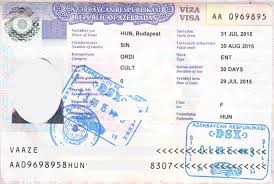
As you can see foreign country travel can be expensive. Travel visas can be expensive. Fortunately, Macedonia does not require a visa for United States tourists coming into the country.
TIME ZONES

Macedonia is nine hours ahead of the Pacific (Los Angeles) time zone. The race on Sunday was scheduled to begin at 12 noon in Skopje. When the green flag drops we will have been in country for about 36 hours. When the green flag drops it will be 3 a.m. Pacific time!
BOOTS ON THE GROUND
Initially, it was generally difficult to get local information about Macedonia racing. The Randy Lewis Racing research department has some proprietary methods that get us good actionable information about these foreign race dates. Without RLR and scouts around the world, I could never do this.
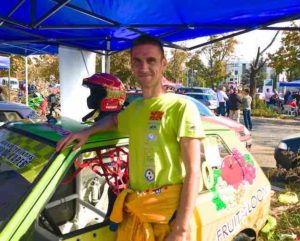
Yes, without a young man by the name of Nikola Popevski I probably would never have made it to Macedonia. He and I first started talking about three months ago. We exchanged well over fifty messages.
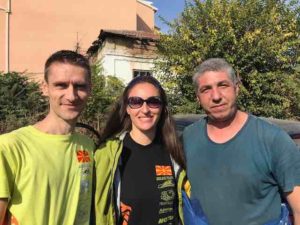
A young woman by the name of Maja Milosevska also jumped in to help with this trackchasing effort. She’s the general secretary of the Avto Karting Klub. Maja was very enthused about the possibility of my visit.
We had a great plan for the first race scheduled for Kicevo. I would fly into Skopje and get a hotel. Nikola would make arrangements for me to get a ride to the track. Then I would hang out with their race team all weekend. That was a great plan.
About this time I got in contact with my good buddy, Bosnia and Herzegovina race driver Boris Miljevic. When Boris isn’t working as a professional race driver/team manager, he’s always up for a trackchasing adventure.
Boris and I came up with a plan where he would drive 10 hours from his hometown of Banja Luka in BiH. We would check out a race in Serbia and then run down to Macedonia for their Kicevo race. Then they canceled the Kicevo race!
Boris and I had trackchased together in BiH as well as Hungary last year. He’s a great travel partner. He is essentially up for anything and that’s the kind of mindset you need in order to have the most trackchasing production AND the most fun.
THE TRANSPORTATION
I frequently have airline sponsorships on my domestic TC trips. When I TC internationally I prefer to buy my airline tickets in advance. There’s just too much risk in flying that far on a standby basis. That’s what I did for the first race in Kicevo. As mentioned I lost the complete value of that ticket. However, I did find a replacement trip that weekend. I ended up adding six new tracks in Ontario, Canada, Pennsylvania, North Carolina and Maryland. Yep. It’s hard to keep a good trackchaser down.
Now I had my second airline ticket to Macedonia. I wasn’t 100% confident this race in Skopje would come off after my Kicevo experience. Nevertheless, I simply chose to “believe”.
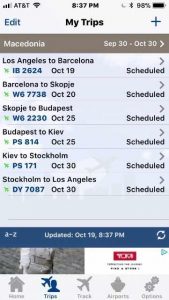
Our airline itinerary was daunting. The complete plan looked like this.
Los Angeles, California – Barcelona, Spain – 11H45M
Barcelona, Spain – Skopje, Macedonia – 2H45M
Skopje, Macedonia – Budapest, Hungary – 1H30M
Budapest, Hungary – Kiev, Ukraine – 1H40M
Kiev, Ukraine – Stockholm, Sweden – 2H30M
Stockholm, Sweden – Los Angeles, CA – 11H0M
Folks, that’s 32 hours and 10 minutes of flying. It would be 14,324 air miles from LAX back to LAX. Don’t worry it’s what I do. Macedonia would be the 76th country where I have trackchased. This flight plan wasn’t even in the top five longest trips I’ve taken.
On the ground, we would use taxis and Uber. Then I discovered Macedonia doesn’t have Uber! Also, I might get a ride here and there from the new friends I would be meeting in Macedonia. No rental cars on this trip.
CURRENCY
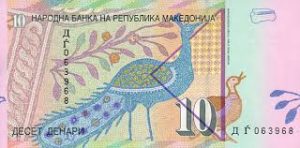
The official currency in Macedonia is the Macedonian denar. Right now one U.S. dollar will buy 52 denars. As an example, if we see something priced at $1,000 denars we’re going to know that’s about $20 U.S. I’ve got a great international currency app on my iPhone.
Carol is my international currency dealer. I don’t know how she does it. I simply tell her where I’m going and a pile of local currency shows up on my desktop a day or two later. What would I do without her?
For this trip, we couldn’t get any Macedonian denars from our local Citibank branch. We could get euros though. When we get to Macedonia we’ll go to a moneychanger. There we can exchange some euros for denars. One euro will get us about 61 denars.
WEATHER
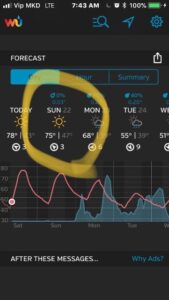
We’re going to be in Macedonia for five nights. The weather for our first two days, including race day, will be very good. We’re expecting temperatures in the low 70s with sunshine and no rain. The last three day’s forecast calls for rain and falling temperatures. We’ll try to really enjoy those first two days of the trip. Then we will do our best to get through the colder and rainier weather days. It was good to see the forecast for race day was perfect.
OVERNIGHT ACCOMMODATIONS
When Carol comes along on these trips I try my very best to get outstanding accommodations. I may have outdone myself in Skopje. I found a hotel on a ship!

We would be staying for five nights at the Hotel Senigallia. It’s located on the water, the Vardar River, in the city centre of Skopje. The reviews and pictures from this unique hotel were top notch. As we go along I’ll tell you and show you what it was like to stay at the Hotel Senigallia.
THE RENTAL CAR
We won’t have a rental car. I was thinking we would use Uber quite a bit in Macedonia. I’ve used them in Croatia. The advantage of Uber in these foreign places is that the system bypasses the language and foreign currency barriers. Of course, then I learned that Uber doesn’t operate in Macedonia!
NAVIGATION
I’ll likely use Waze and/or Google Maps when we’re walking around Skopje. Of course, ten years ago this capability would never have existed. If you don’t love technology you should. Remember, the purpose of tech is to make life easier.
THE TRAVELING COMPANION
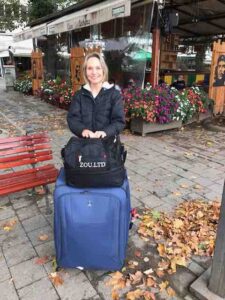
I’m pleased to report that Carol is coming along on this trip. She wasn’t part of the first trip plan. Maybe I’m just lucky that first trip was aborted.
Carol’s Czech heritage emanates from Eastern Europe. She should be right at home with these blonde-haired beauties.
Trips like this are time drains for Carol. Remember she does 99-100% of the work at home. Yes, that’s a pretty high percentage, isn’t it? However, as the World’s #1 Trackchaser I am frequently on the road trying to maintain my title. That leaves Carol to “take care of business” back at the ranch. She’s a hard worker and very much appreciated for what she does.

Carol has seen racing in 40 different countries. No other woman trackchaser comes anywhere close to that total and likely won’t for years if ever. She’s looking to add to her total on this trip.
THE SUMMARY
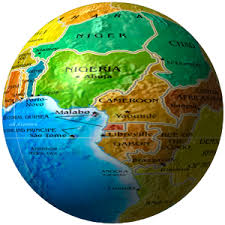
My “world map” has filled up surprisingly quickly. How many more countries can I visit where I can see a race for the first time? I don’t know. I do know there are still a few places left to make that first visit. The Randy Lewis Racing research department is working behind the scenes for the next opportunity as you read this.
RLR – Randy Lewis Racing Lifetime Trackchasing Countries
# 1 – UNITED STATES OF AMERICA – Peoria Speedway – Mt. Hawley (oval) – Track #1, Peoria, Illinois – circa 1955
# 2 – CANADA – Cayuga Speedway (oval) – Track #174, Nelles Corner, Ontario – 1988
# 3 – AUSTRALIA – Parramatta City Raceway (oval) – Track #180, Granville, New South Wales – 1989
# 4 – UNITED KINGDOM – Northhampton International Raceway (oval) – Track #378, Northhampton – 1999
# 5 – NETHERLANDS – Driesum Racetrack (oval) – Track #839, Driesum – 2005
# 6 – BELGIUM – Bellekouter oval (oval) – Track #841, Affligem – 2005
# 7 – FRANCE – Circuit de Croix en Ternois (road course) – Track #843, Saint-Pol sur-Ternoise – 2005
# 8 – GERMANY – Nurburgring (road course) – Track #844, Nurburg – 2005
# 9 – NEW ZEALAND – Western Springs Speedway (oval) – Track #1,134, Western Springs – 2006
# 10 – MEXICO – Triovalo Bernardo Obregon (oval) – Track #1,281, Tiajamulco de Zuniga, Jalisco – 2007
# 11 – BARBADOS – Bushy Park Racing Circuit (road course) – Track #1,296, Bushy Park – 2007
# 12 – THAILAND – Bira Circuit (road course) – Track #1,300, Pattaya – 2008
# 13 – SOUTH AFRICA – Durban Grand Prix (road course) – Track #1,315, Durban, KwaZulu-Natal – 2008
# 14 – JAMAICA – Dover Raceway (road course) – Track #1,322, Brown’s Town St. Ann – 2008
# 15 – SWEDEN – Sturup Raceway (road course) – Track #1,335, Malmo – 2008
# 16 – DENMARK – Ring Djursland (road course) – Track #1,336, Tirstrup – 2008
# 17 – CZECH REPUBLIC – Automotodrome BRNO (road course) – Track #1,381, Brno – 2008
# 18 – AUSTRIA – Lambrechten Stock Car Track (road course) – Track #1,382, Lambrechten – 2008
# 19 – IRELAND – Tipperary International Raceway (oval) – Track #1,388, Rosegreen – 2008
# 20 – GUYANA – South Dakota Circuit (road course) – Track #1,390, Timehri – 2008
# 21 – CHINA – The Guia Circuit (road course) – Track #1,392, Macau – 2008
# 22 – COSTA RICA – Autodromo La Guacima (road course) – Track #1,398, La Guacima – 2008
# 23 – ANDORRA – Grandvalira Circuit (road course) – Track #1,404, Port d’Envalira – 2009
# 24 – ARGENTINA – Circuito Efren Chemolli (oval) – Track #1,406, Buenos Aires – 2009
# 25 – QATAR – Losail International Circuit (road course) – Track #1,408, Doha – 2009
# 26 – BAHRAIN – Bahrain International Circuit (road course) – Track #1,410, Sakhir – 2009
# 27 – UNITED ARAB EMIRATES – Dubai Autodrome (road course) – Track #1,411, Dubai – 2009
# 28 – COLOMBIA – Autodromo de Tocancipa (road course) – Track #1,415, Tocancipa – 2009
# 29 – SPAIN – Motorland Aragon (road course) – Track #1,416, Alcaniz – 2009
# 30 – PORTUGAL – Circuto de Murca (road course) – Track #1,417, Murca – 2009
# 31 – ICELAND – Kapelluhraum (road course) – Track #1,420, Hafnafjorour – 2009
# 32 – HUNGARY – Hungaroring (road course) – Track #1,426, Mogyorod – 2009
# 33 – SWITZERLAND – Hock Ybrig (road course) – Track #1,427, Hoch Ybrig – 2009
# 34 – ITALY – Vighizzolo d’Este Stock Car Track (road course) – Track #1,428, Vighizzolo d’Este – 2009
# 35 – DOMINICAN REPUBLIC – Autodromo Mobil 1 (road course) – Track #1,515, Santo Domingo – 2009
# 36 – MALTA – Ta’Qali Race Track (road course) – Track #1,521, Ta’Qali – 2010
# 37 – FINLAND – Lake Pidisjarvi Ice Track (road course) – Track #1,524, Nivala – 2010
# 38 – JAPAN – Suzuka Circuit (road course) – Track #1,530, Suzuka – 2010
# 39 – CHILE – Autodromo de Interlomas (road course) – Track #1,531, Temuco – 2010
# 40 – MOROCCO – Circuit de Marrakesh (road course) – Track #1,535, Marrakesh – 2010
# 41 – BRAZIL – Circuit de Caruaru – Aryten Senna (road course) – Track #1,540, Caruaru – 2010
# 42 – ESTONIA – Laitse Rally Park (road course) – Track #1,571, Laitse – 2010
# 43 – LATVIA – Bikernieki (road course) – Track #1,572, Riga – 2010
# 44 – GUATEMALA – Autodromo Pedro Cofino (road course) – Track #1,580, Alotenango – 2010
# 45 – EL SALVADOR – El Jabali (road course) – Track #1,582, Quezaltepeque – 2010
# 46 – ROMANIA – Bradu (road course) – Track #1,603, Bradu – 2010
# 47 – BULGARIA – Closed Route – Burgas (road course) – Track #1,604, Burgas – 2010
# 48 – SOUTH KOREA – Korea International Circuit (road course) – Track #1,605, Yeongam, Jeollanam-Do – 2010
# 49 – PHILIPPINES – Batangas Racing Circuit (road course) – Track #1,608, Batangas – 2010
# 50 – NORWAY – Lyngas Motorbane (road course) – Track #1,648, Lier – 2011
# 51 – MALAYSIA – Sepang International Circuit (road course) – Track #1,656, Sepang – 2011
# 52 – INDONESIA – Sentul International Circuit (road course) – Track #1,657, Babakan Madang, Boder – 2011
# 53 – LUXEMBOURG – Alzingen (road course) – Track #1,711, Alzingen – 2011
# 54 – POLAND – Tor Slomczyn (road course) – Track #1,713, Slomczyn – 2011
# 55 – SINGAPORE – Marina Bay (road course) – Track #1,714, Singapore – 2011
# 56 – URUGUAY – Piriapolis Grand Prix (road course) – Track #1,724, Piriapolis – 2011
# 57 – SRI LANKA – Pannala Race Track (road course) – Track #1,732, Pannala – 2012
# 58 – ECUADOR – Autodromo Internacional de Yahuarcocha (road course) – Track #1,736, Ibarra – 2012
# 59 – SLOVAKIA – Slovakia Ring (road course) – Track #1,745, Orechova Poten – 2012
# 60 – MONACO – Circuit de Monaco (road course) – Track #1,747, Monte Carlo – 2012
# 61 – CROATIA – Automotodrom Drobnik (road course) – Track #1,762, Rijeka – 2012
# 62 – PERU – Autodromo La Chutana (road course) – Track #1,802, Lima – 2012
# 63 – GREECE – Serres Circuit (road course) – Track #1,807, Serres – 2012
# 64 –RUSSIA – Moscow Central Hippodrome (oval) – Track #1,824, Moscow – 2013
# 65 –LITHUANIA – Marijampole Autocross Track (road course) – Track #1,842, Marijampole – 2013
# 66 –INDIA – Buddh International Circuit (road course) – Track #1,915, Noida – 2013
# 67 –GEORGIA – Rustavi International Motorpark (road course) – Track #1,916, Rustavi – 2013
# 68 –TRINIDAD AND TOBAGO – Larry Gomes Stadium (road course) – Track #1,928, Arima – 2014
# 69 – TURKEY – Istanbul Park (road course) – Track #2,035 Akfirat – 2014
# 70 – AZERBAIJAN – Streets of Baku (road course) – Track #2,037, Baku – 2014
# 71 – SERBIA – Usce (road course) – Track #2,224, Belgrade – 2016
# 72 – BOSNIA AND HERZEGOVNIA – Zaluzani (road course) – Track #2,235, Banja Luka – 2016
# 73 – PANAMA – Circuito Internacional de Panama (road course) – Track #2,290, La Chorrera – 2016
# 74 – ZIMBABWE – Bulawayo Motorsports Park (road course) – Track #2,291, Bulawayo – 2016
# 75 – NAMIBIA – Desert Raceway (oval) – Track #2,369, Walvis Bay – 2017
Coming in a day or two……
# 76 – MACEDONIA – Skopje Street Course (road course) – Track #2,386, Skopje – 2017
Yes, one might think I am running out of countries for that next trackchasing trip. It is getting harder….but I’m not done yet!
So how did this trip really come down?
Thursday – October 19, 2017

This trip would require a good bit of luggage planning. I’ve been flying every week since I was 23 years old. For most of that time, airlines allowed you to check bags for free. They don’t do that anymore, the greedy SOBs. I guess I can’t complain. They are in business to make a profit. As long as their customers are willing to pay baggage fees the airlines will keep charging for bags.
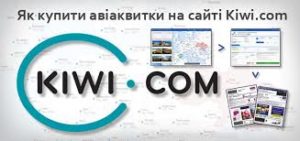
I used Kiwi.com for our airline tickets on this trip. I had never heard of them but they were the low bidder. I paid $200 U.S. so that we could check one bag on all six flights. We’re going to be gone for 12 days on this vacation. One checked bag plus our carry-ons isn’t that much for two people for twelve days.
We also used a strategy I’ve been employing for years now. I stuff the sleeves of my jacket with as much heavy stuff as the jacket will hold. That allows us to “make weight” with our one checked bag. I also reviewed each of the airline’s websites that we would use. There I got the bag dimensions and weights that were allowed. Sometimes the information wasn’t clear. The allowable dimensions were all over the board.

On the way up to the Los Angeles International Airport (LAX) we stopped off at our favorite Peruvian restaurant, El Pollo Peruano. I love that place, especially their concha (fried corn) appetizer. This eatery is too far from our home to make regular stops unless we are coming or going to LAX.
We left home bound for LAX a full five hours and 40 minutes before our flight was scheduled to leave Los Angeles. First, we were flying non-stop to Barcelona, Spain. In Barcelona, we would make a connection, after a three-hour layover, bound for Skopje, Macedonia.
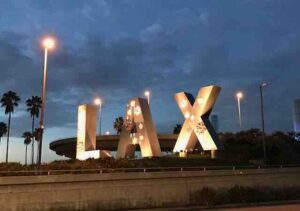
Of course, we would be driving through the heart of LA’s evening rush-hour traffic. After dinner, I dropped off Carol at the airport terminal to check our bag. I went to park the car and walked back to the Tom Bradley international terminal. By this time we were down to only two hours before flight time. When we cleared security and the like the plane was leaving in a little bit more than an hour. There really are a lot of small details that need to be handled to make a trip like this run smoothly at a reasonable cost.
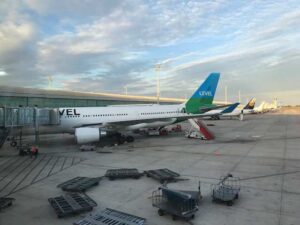
We would be flying on an airline that had only been operating for four months. We thought we had a ticket on Iberia Airlines. In reality, we were on the discount version of Iberia, which is called Level Airlines. I had never heard of Level. Neither had our commercial airline pilot son!
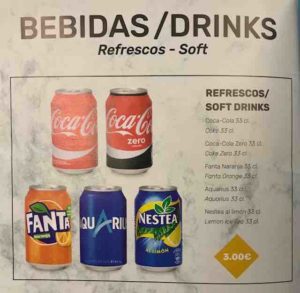
The flight was more than 11 hours long. It really wasn’t bad. The plane had a brand new cabin interior, complimentary movies as well as food and drink available for purchase. Granted a can of soda did cost three euros or a little bit more than three dollars. At least food and drink was available. We had already gotten a pretty good rate on our flights.
Friday – October 20, 2017
We left Los Angeles last night at 10 p.m. However 10 p.m. in Loss Angeles was 7 a.m. the next day in Barcelona, Spain. By the time we arrived in Spain, it was past 6 p.m. The flight had taken 10 hours and we lost nine hours due to time zone changes. With our second flight coming up in less than three hours we didn’t have many options for quick dining. We chose a Burger King inside the airport. I’m not a big fan of Burger King. I am really not a big fan of eating at Burger King on an international trip.
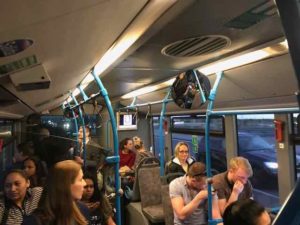
We had to ride a shuttle bus for about 15 minutes from Barcelona‘s main terminal over to the terminal that serves budget airlines. For the first time ever we would be using super budget airlines, Wizz Air.
We will fly on six different airlines on three different days on this trip. None of those airlines can pass our checked bag onto the next. Don’t ask me why. Just know that is a fact. This meant that after each flight we had to retrieve our bag, find the next airline and then check our bag with them.
To get our checked bag from one flight to the next we had to clear border control to get us into the country where we had just landed. We then found our bag and went to the departures area to check the bag onto the next flight. When that was done we went to clear border control to leave the country we had only entered an hour or so ago!
We would do this routine in Spain, Hungary and Sweden on this trip. We don’t see very many Americans traveling abroad. Maybe it’s just too much hassle for older folks who have the most time and money to travel. To me, it’s just part of what is required to get to the fun places we visit.
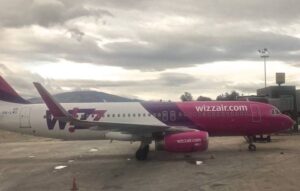
Our second flight of the trip would move us from Barcelona, Spain over to Skopje, Macedonia. The Wizz Air flight was scheduled for two hours and 45 minutes. We were assigned seats in the last row of the plane. In my opinion, the last row of the plane is the worst row to sit for an airplane ride.
We arrived in Skopje at about 15 minutes past midnight. It took about 15 minutes to clear border control. We grabbed our checked bag. I attempted to call Uber. I thought I had read on TripAdvisor that was a big idea in Macedonia. It turns out that Uber doesn’t operate at all in Macedonia!
It was easy to grab a cab from the airport to the hotel. The cost was €20 or about $23.50 U.S. There was absolutely zero traffic, as you might imagine, on the roads at 1 a.m. Our driver, a very nice guy, took us to the doorstep of our hotel in the city centre of Skopje. We’re staying at the Hotel Senigallia.
I had made a nonrefundable five-night reservation at the hotel a week or two ago. This non-refundable strategy saved us about 50 bucks. I was taking a risk doing that but today that risk paid off. I had already decided if the Macedonia race was canceled again we were still going to make the trip.
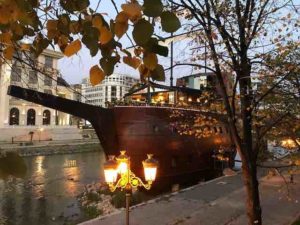
You will not want to miss the pictures of our hotel. It was exactly like staying overnight on a cruise ship. The exterior of the hotel looks like a ship from a few centuries ago. I met up with another worldwide traveler who had visited Macedonia. He told me that staying at the Hotel Senigallia was one of the highlights of his trip. I think it will be for ours as well.
Saturday – October 21, 2017
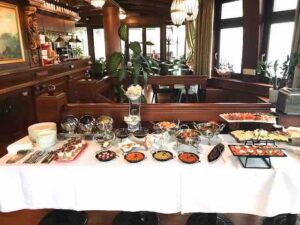
One of the nice things about the Hotel Senigallia, in addition to its location and shipboard ambiance, is that breakfast is included each morning. It really is like dining aboard a cruise ship.
I stopped by the front desk to get directions for where we could exchange money. We were looking to take a local walking tour of the city as well. Everyone we met in Macedonia speaks English well. No problems there.
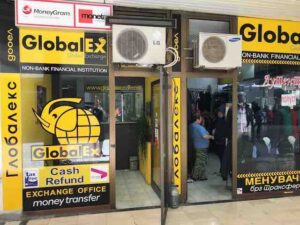
I use TripAdvisor in advance of taking these trips. I search the forums to learn from others about their experiences in whatever country we are visiting. We had been advised on TripAdvisor not to exchange money at the airport or in hotels. The exchange rates were unfavorable. It was convenient to go to a “moneychanger” right across the street today. According to others, they offered the best exchange rates. There we traded €50 for 3,062 Macedonian dinars. Right now one euro will buy you about 62 dinars.
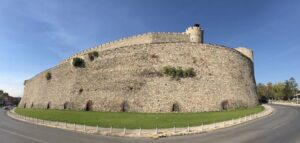
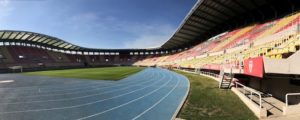
The front desk clerk advised us to take a walk along the Vardar River. On this walk, we would pass the Old Bazaar section of Skopje. There was also the old fortress to see and a huge city park where the leaves were changing to all of the fall colors. The weather was gorgeous. We stopped inside the Philip II Arena. This was a huge football stadium (soccer to us!) There wasn’t a cloud in the sky with temperatures of 75-80° Fahrenheit in mid-afternoon.
After logging four miles of walking it was time for lunch. In European countries and Macedonia in particular, lunch can be as late as three or four in the afternoon. Dinner often follows at nine or ten at night.
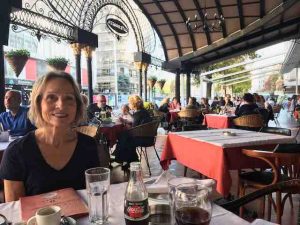
We found a lovely little bistro along one of the side streets. It had an Italian theme and a very extensive menu. There must have been 40 desserts offered as well as over 100 entrées.
We couldn’t believe our eyes when we saw the prices on the menu. Most of the time when someone says that they’re talking about high prices. In Macedonia, it was completely the opposite. Prices are so low as to be nearly unbelievable.
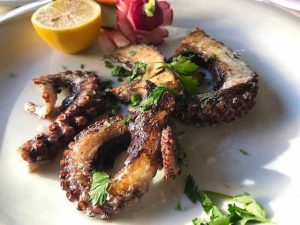
We had three soft drinks, two coffees, an appetizer of fried cheese, an entrée of grilled octopus (above), a salmon and pasta dish as an entrée and one of the best and largest pieces of chocolate cake along with vanilla ice cream. All of this was served impeccably in an upscale dining atmosphere. What do you think five drinks, an appetizer, two entrées and dessert would cost for two people in such a place? Did you say $32 U.S? If you did you are correct! In any big city fancy restaurant that meal goes for three times that price or more.
I’m working with a special AT&T international phone plan. For $10 a day my phone pretty much works exactly as it does at home. That includes Wi-Fi, phone calls, texting, messaging…the works with unlimited data. This is the first time I’ve ever been to a foreign country outside of North America with this capability. It’s going to come in very handy. I will need to make contact with several people in foreign countries to make this trip work well. This plan saves time and actually reduces expenses beyond the $10 a day it costs.
My main contact in Macedonia, Nikola Popevski messaged me. He was following up on my request to take a look at his racing garage. He offered to come to pick us up but we decided to take a taxi to make it easier for everyone.
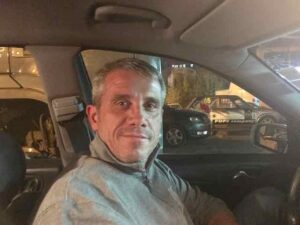
Our taxi driver (above) got lost and took us to the wrong location. That wasn’t a problem. He was a real nice guy and turned off the meter at that point until we actually found where we needed to be. In the meantime, Nikola and I were sending photos via Messenger to help us find each other easier! The total taxi bill was about three bucks. We had been in the cab for more than 20 minutes. We were beginning to see just how inexpensive Macedonia is to tour.
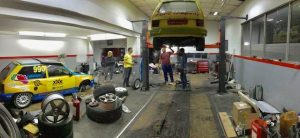
We would be meeting Nikola for the first time. He was a very friendly and outgoing person. He spoke English well. Nikola is president of his racing team. It’s called Avto Karting Klub. The team has 10 cars in total. Tonight they were working on a couple of the racers in a two-car garage with lifts. A couple more cars were stationed outside.
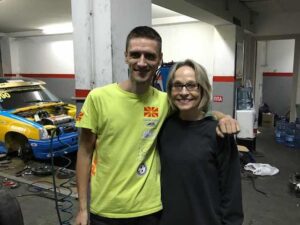
We sat down with Nikola for a long time and chatted about a number of things. We had a chance to get some great photographs inside the garage of the cars. We’ll be watching Nikola and his friends race tomorrow. After the races, we will get together again for a celebration dinner with the entire Avto racing team.
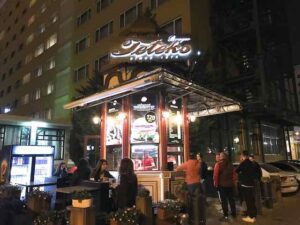
We grabbed a cab for the ride home. The taxi driver dropped us near our hotel. This was unusual but Carol was hungry. She doesn’t eat much. That’s why she’s in the best shape of any trackchaser! Just down the street was a little kiosk selling hamburgers. We had seen they were doing great business day and night out of a cooking space that couldn’t have been much more than 25 square feet. Again we couldn’t believe the prices for the quality they were providing.
They were selling a huge hamburger on an even larger bun with French fries for about $1.60 U.S. Imagine a half-pound hamburger with about a half a loaf of bread as well as fries for that price. It almost makes me want to move to Macedonia.
We were back in the hotel room by about 8:30 p.m. We’ve only been in Europe for 20 hours. With a nine-hour time change from California, we will slowly work ourselves into the local time. Tonight was our first night in a hotel after sleeping on the plane to get to Europe. Getting a good night’s sleep was important. Tomorrow was race day!
Yes, tomorrow’s going to be a very good day. I’ve seen racing at nearly 2,400 tracks. However, up until now, I’ve only been able to say on 75 individual mornings, “I’m going to be seeing racing today in a country for the very first time”. Tomorrow morning Macedonia will be number 76.
Sunday – October 22, 2017
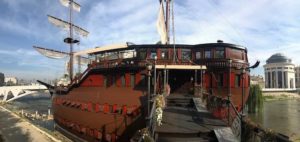
Each morning we began with breakfast on our ship…er, in our hotel. In our room, we almost felt as if we were swaying with the ship. However, we knew this hotel had never been a ship. It was a hotel built to look like a centuries-old sailing ship.
Breakfast was served until 10 a.m. each day. We always perused the buffet for bread, cheeses, jellies and various meats. We supplemented that with cooked to order omelets and European pancakes (called crepes in the U.S.). The orange juice was always fresh-squeezed.

Today was a special day. Racing had been the reason for coming to Macedonia in the first place. However, it never takes long for the people we meet and the sights we see to overshadow the actual racing. Yes, today was race day. If all turned out well we would be seeing racing in my 76th country and Carol in her 41st.
The weather was fantastic. The temperature topped out at about 75° with a slight breeze and generally clear skies. Tomorrow night Skopje is expecting a half an inch of rain. We beat the bad weather by about 24 hours.
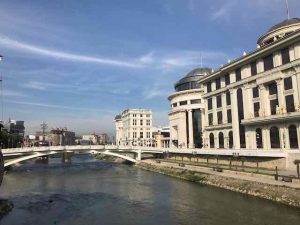
It was a short 10-15 minute walk from our hotel over to where the racing would take place. Today’s racecourse was essentially a street course. The streets in the area were blocked off. I’m guessing the length of the course was about two miles maybe a little bit less.
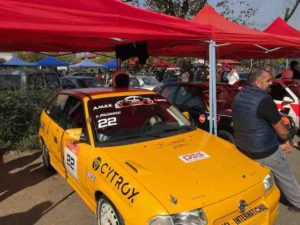
We quickly found the racing paddock area. On other days this flat space is used for city bus parking. There were 20-25 racecars all prepared and ready for action. Today there would be six classes racing in four divisions in four races.
It was easy to find Nikola’s Fruit of the Loom sponsored racing Yugo. He carries car number 900. He had to add a zero at the end of his number to differentiate himself from other car number 90s that might come from outside the area.

Nikola gave us the lowdown on how the race program was going to happen today. Then we met Maja Milosefska for the first time. She was a lively and vivacious supporter of the Avto Karting Klub. Maja is the general secretary. She had messaged me a few times with info about Macedonia racing. Maja took us over to the driver’s briefing a.k.a. the driver’s meeting.
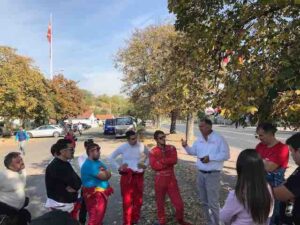
We listened to the meeting but didn’t really understand what was being said. As you might expect the entire meeting was instructed in the Macedonian language. Following the meeting, Maja and Nikola gave us the low down of today’s race plan in English.
It was going to be a little difficult to see the racing today. Except for a couple of small chicanes, the course was essentially a very very long oval with long straightaways and tight turns. Nevertheless, with the chicanes that made today’s race configuration a road course.
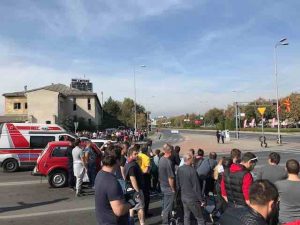
Probably 90% or more of the people in the crowd were men and small boys. Most positions along the entire course hosted a crowd that was 3-4 and sometimes as many as six or eight deep. There wasn’t much protection and sometimes none between where the cars were racing and the fans are standing.
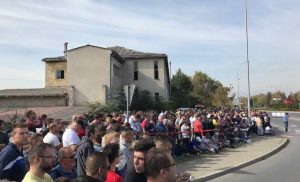
Barriers are expensive. They had not run this race on the streets of Skopje for seven years. The racing budget here doesn’t allow for a lot of expense when it comes to safety. The police do what they can but if a car were to get out-of-control it could create problems.
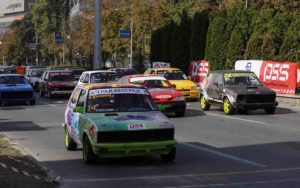
I took photos and videos from around virtually the entire course. My viewing points weren’t great. We moved around enough to get a little bit of video from just about everywhere along the circuit.
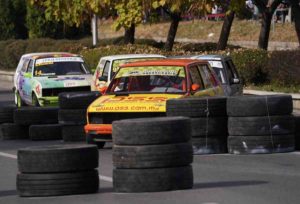
Nikola was racing in the first race of the day. This event was exclusively for the Yugos. They had 12 competitors. That was the most of any particular class racing today. Some classes had to be combined into one division in order to make enough for an individual race.
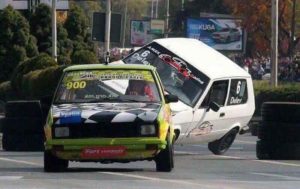
Your best bet, to get a full understanding of Macedonia street racing is to look at my photo album as well as my racing video. I’ve seen racing in 76 countries now. All but about five or six raced on road courses as opposed to the ovals that dominate several English-speaking countries.
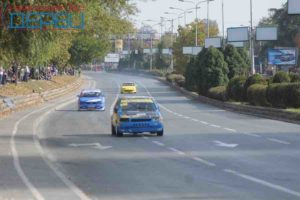
Nikola started sixth in today’s 12-car Yugo field. By the end of the 20-lap race he was scored third. That meant he had earned a position on the podium. Way to go Nikola! Each of the four races today would run for twenty circuits.
At the beginning of the third race, we attempted to double back and revisit the paddock area. However, the police blocked our path. We had to take a walk through a residential neighborhood to get back to the paddock.
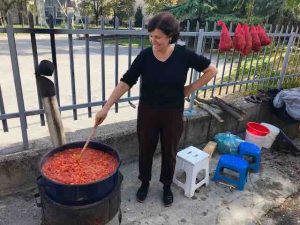
This was actually an interesting and educational walk. We passed women making huge pots of what looked like chilly outside their homes in their backyards. These pots could have fed an army. I’m suspecting they were making such large quantities to can for the winter. The delicacy is a sauce-like mixture called Ajvar. Folks put it on lightly fried or baked cheese. We also walked by some areas of older more communist era style construction. It was all very interesting and a nice brief break from the racing.
When the third race was finished we elected to bypass the fourth and final event. We had been walking around for more than three hours in the sun. That race would turn out to be quite a dramatic encounter. I wouldn’t know that until we reunited with the Avto Karting Klub racing team for dinner tonight.
We had already covered more than 4 miles of walking today. We were still getting acclimated to the nine-hour time change. Today’s racing began at 12 noon. That was 3 a.m. our time back in California. The situation called for a one-hour nap back in our stateroom. I’ve learned one thing from all of these trips. It’s important to pace yourself.
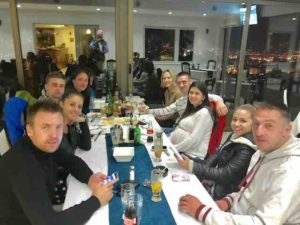
Nikola had invited us to the Avto racing team’s season-ending dinner banquet. We would be their guests at a very upscale restaurant. It had a beautiful view of Skopje’s nightscape.
It was at dinner when Nikola informed us of a major accident that occurred on the 13th circuit of the fourth and final race. One of the drivers had lost control of his machine on the straightaway near the starting line. He slammed into the race organizer who was handling the flagging duties. The starter, another individual as well as the driver were all injured. The race organizer was the most seriously injured with two broken legs and other assorted injuries.
At dinner, I was shown a video and several photographs of the accident as it happened. It didn’t look good. We’re hoping for the best for the injured folks. Ironically, the second person less seriously injured was the brother of the driver who initiated the accident. Once I’m told that everyone is going to be O.K. I have Nikola’s permission to share the video and photos of this terrible accident.
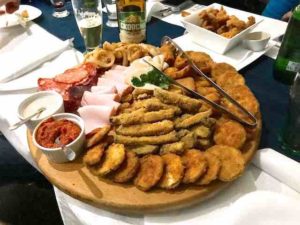
It was fun going to dinner with all of our new Macedonian friends. They all race for the same club that includes 10 different racing cars. I’ve actually seen a photo of a car hauler they use that transports ten racecars! This is a younger group of people all in the age bracket of probably 30-45. Everyone seemed to be having a good time. We dined on all kinds of Macedonian specialties.
At nearly 11:30 p.m. it was time to head back to the hotel. We were in taxies three or four times every day on this trip. Each trip’s fare came to about three bucks. Taxis are just one of the things that are very reasonable in Skopje.
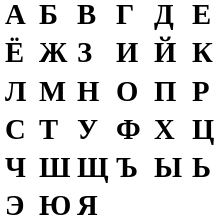
The last half of our eastern European trip will be in Ukraine. This afternoon I started planning what we’re going to be doing in Kiev, Ukraine. I went on a website for Ukraine’s National Theatre. Even though the website was using the Cyrillic alphabet exclusively I was able to order a couple of tickets to the Sleeping Beauty ballet. If you’ve never shopped a site with the Cyrillic alphabet give it a try sometime! By the way, I’ve read several trackchasing reports from other chasers over the years. I can’t ever recall one of them mentioning they attended a ballet during a trackchasing trip!
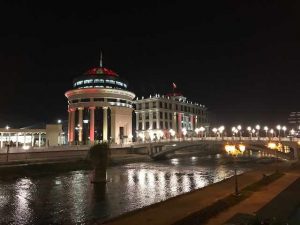
It was a very good day. From a spectating point of view, we couldn’t see the racing all that well. Nevertheless, the actual racing on one of these trips is definitely a secondary entertainment aspect for me. These trips are all about meeting the people who often become my friends for a very long time. Following the people, it’s the sights offered in these beautiful countries that make these adventures so special.
Monday – October 23, 2017
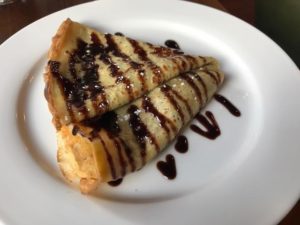
We started each of our mornings in Skopje with breakfast at Hotel Senigallia. This morning I discovered for the first time their “pancakes”. To American’s the “pancakes” are really crepes. Today they were filled with Nutella chocolate. Quite tasty!
The main item on the agenda today is the touring of Skopje, the capital city of Macedonia. Skopje is also the largest city in the country with about 500,000 people. I consulted TripAdvisor and found there were free walking tours offered each morning at 9 a.m. These tours were highly recommended. They were free with tips at the end for the tour guide. These were in-depth views of the city. Today’s tour lasts some 3 ½ hours.

Our guide (above left) was an enthusiastic man of about 50 years of age. Mika had retired from the casino business. Now he owns a café and does these morning tours virtually every day. He spoke English well and was very passionate about his job. We walked all over the city center and the Old Bazaar section of Skopje. Mika gave us his recommendations for other things to see and places to eat. It rained a bit, to begin with, but then the temperature rose to nearly 70 degrees as we enjoyed the tour with about 12 other tourists.
There was one thing on the tour that I never would have expected. I hadn’t seen such a thing in a very long time. There was a pack of three or four dogs that continued to chase cars and bark as if they were auditioning for a part in Cujo. At home every dog I see in on a leash! Most of these dogs followed our group for the entire tour. They scared the daylights out of people passing by on bicycles.

Skopje is a city statues. I’ve never seen a place with more statues. They had statues every few feet all over the city. The roofs of taller buildings had statues about every ten feet. You probably can’t go anywhere within the city centre of Skopje and not see a statue within 40-45 meters of where you are standing. Amazing!
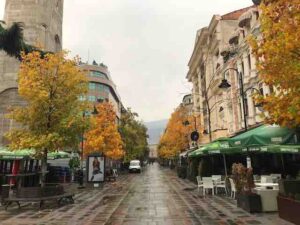
We met a young man in our touring group from Minneapolis. He was visiting a few eastern European countries on his 11-day trip. “Jake” was easy to talk to. He gave us a great recommendation for Ukraine touring. More on that later. The tour began in the rain but ended in sunshine.

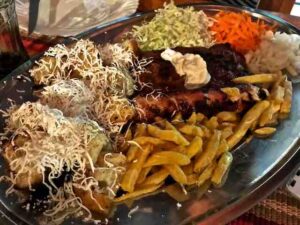
Mika, our tour guide had received many outstanding TripAdvisor reviews. Toward the end of the tour, he gave us some recommendations for restaurants. We followed up on what he was suggesting. We had a beautiful lunch in a centuries old-style restaurant in the Old Bazaar section. There we dined on Sharska (meat filled with cheese) burgers, rolled pork and other Macedonian delicacies. The bill for our lunch, including two drinks for each of us and a huge platter of food, came to about $10 U.S.
When the tour was finished it was time to tip our guide. We were very generous. He had done such a good job. Most people shared their appreciation. There were two young fellows who had been part of the tour for the full 3 ½ hours. When the event wrapped up they slithered away to the side without a thank you or a gratuity for our guide.

I thought this was in extremely poor taste. How does someone take advantage of a situation like that? Mika personally directed us to the restaurant he had recommended earlier. Who was already at the restaurant about ready to order their second beer? The two young guys who had stiffed Mika!
Carol says that people who don’t share whatever they have with others will never be successful. I believe that 100%. If you’ve ever dined with me you know I am the first guy to pick up the check. I’ve run into a few people who have very deep pockets and very short arms. Being cheap just doesn’t get it with me. You don’t have to be Warren Buffet to do the right thing when it comes to money. The really hilarious thing is that the cheap guy thinks he’s fooling everyone when he doesn’t contribute his share. He isn’t fooling anyone but himself.
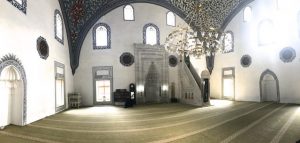
During the afternoon we continued to tour the old town section of Skopje. These old-time areas, sometimes hundreds of years old, are often called the medina. Today we had walked 7.55 km or nearly 5 miles. A highlight was stepping inside a Muslim mosque. I’ve done that in a few countries. I’ve always been allowed to take photos of the unusual site (to me) as I was today.
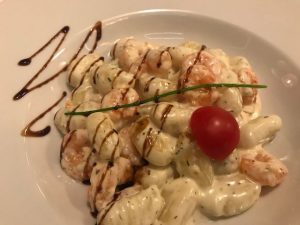
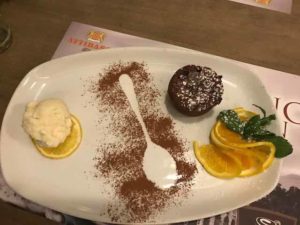
Nikola had recommended a restaurant for us to try tonight. It was just a one-minute walk from the hotel. That was convenient because it was beginning to get mighty cold in the evenings. At the Bella Vista restaurant, we had several drinks, some alcoholic, a starter, two entrées and dessert. It was all served in an upscale atmosphere. The price of our entire meal? $28 U.S. The prices in Macedonia for American tourists were unbelievably low for gourmet dining. Yes, we ate well in Macedonia.
I have noticed that people in Macedonia seem to smoke more than just about any country I have visited in the recent past. They are allowed to smoke in restaurants. I haven’t had that smell of smoke all over my clothes in 10-15 years or more. I am so glad that smoking has been outlawed in United States restaurants.
Overall it was a good day of touring and dining. Touring and dining are big parts of these international forays. I’ll try to lose the weight I gain later! This is probably the last day the weather will be decent on this trip. We took advantage of the weather with a very busy day.
Tuesday – October 24, 2017
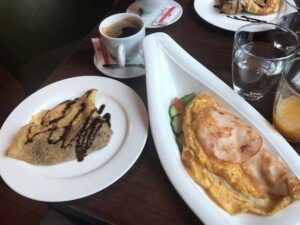
Today we didn’t get rolling until about 1 p.m. O.K., we did take time for the outstanding hotel breakfast. The weather forecast called for rain. That helped us decide against going to Matka Canyon. According to TripAdvisor the canyon and its surrounding areas are the #1 rater tourist attraction in all of Skopje.
Our city tour guide had recommended three “must-see” attractions in Skopje. One was the Matka Canyon. Another was a centuries-old historic church. The final choice was the Archaeological Museum of Macedonia.
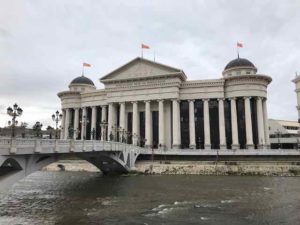
With the Matka Canyon nixed because of the weather forecast and the time of day, we headed over to the Archaeological Museum of Macedonia. My TripAdvisor research told me that photos weren’t allowed in the museum.

I’m not a big fan of these types of museums in the first place. If I couldn’t take a few photos what good would it be to visit the museum? Surprisingly when I asked about photos I was told they are allowed but only without flash. We paid our 300 Macedonian dinars admission per person and off we went.
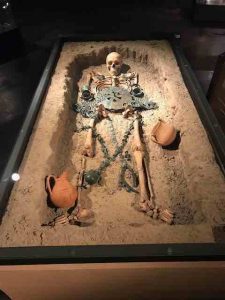
I hate to think that things in life are self-fulfilling prophecies. I didn’t expect much from this museum visit. The museum met my expectations. We probably spent about 30 minutes in the entire place. That was 25 minutes too long for me. Nevertheless, Carol enjoyed it.
From there we were off for a walk into the Old Bazaar section of Skopje. We found the Christian church in the maze of this old-time architecture. Alas, it was closed. I guess we went one for three today seeing our guide’s most recommended activities and that was with a weak single.

Earlier in the trip, Nikola had recommended that we have a Macedonian treat called “Burek” for breakfast. Since the hotel provided such a great breakfast we never ended up having any burek during our morning meal. This afternoon we found a shop selling it. We stopped in this small and old-style bakery. We enjoyed both the cheese and meat versions of burek. It’s got a piecrust flaky texture. Our burek was quite tasty and very inexpensive at 20 dinars or about $0.40 U.S.
The temperature was in the high 40s. It was definitely the coolest day of our trip. I think we were lucky to have three days in the 70-75 range. Now the weather was becoming a little bit more seasonal with temps in the 40s.
Tonight we would be having dinner (to us) with Nikola and his lovely and pregnant wife Monika. Nikola called it lunch. They were going to select a local restaurant for us to enjoy. This dinner would be one of the highlights of the entire trip. How many people, when they go on vacation, get to have a personal dinner with friends they’ve only just met on the trip?

During our walk through town today we did stop at the Macedonian Opera and Ballet theatre. They were having a special ballet performance tonight. That might have been fun to see but as noted we had other better plans.
It’s been a challenge to keep my iPhone battery charged. I never like it to get below 50%. I depend upon it for pictures and also for its messaging capabilities with people who are depending on me.
Each time I get back into the room I immediately plug it into electricity. I get as many charging “points” as I possibly can. Today we confirmed with the hotel front desk manager that our “ship masquerading as a hotel” never was a real ship. We thought we knew that but had to ask to know for sure. As a matter of fact, it’s nearly brand new. It was opened as a hotel on December 2, 2015.
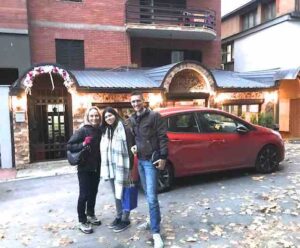
At 5:30 p.m. Nikola and Monika were picking us up for lunch. We had met Monika two nights before at the Avto Karting Klub racing dinner. She and Nikola are expecting their first child in two weeks or so!
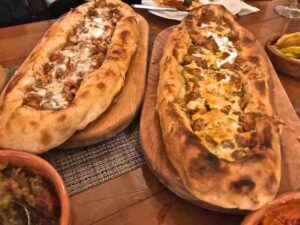
Pastrmajilja is a special delicacy in Macedonia. It’s a dish that is somewhat similar to pizza. Nikola told us the Fodka restaurant offered the very best Pastrmajilja in the entire city of Skopje.
He picked us up in his BMW and off we went over the streets of the city. Nikola was right. Pastrmajilja is delicious and it was nice to know the Fodka restaurant serves the very best version.
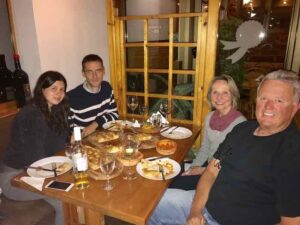
We laughed and smiled all through dinner. I think they were happy to be hosting American guests. We were thrilled to be having such a special treat from our gracious Macedonian hosts.

I had wanted to treat Nikola and Monika to dinner. However, when the check came Nikola grabbed the check and wouldn’t let go. He is a very generous man.
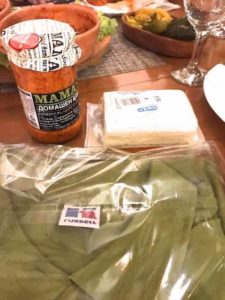
Just having dinner with these two was a treat in itself. Nevertheless, we were in for a special surprise. Toward the end of our get-together, Nikola presented Carol and me with some special gifts. First, we were given matching pale green collared sports shirts. The shirts carried the logo of the Avto Karting Klub racing team. They are beautiful. We will wear them with pride.
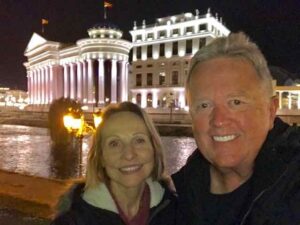
Additionally, we were also given a huge jar of Ajvar. This was the special sauce we had seen local women cooking in those big backyard pots. To go with the sauce was a brick of cheese. Carol will lightly fry it. We’ll add the sauce as we have done a few times this week and think of our friends in Macedonia. The evening ended all too early. We hope to hear in the next few days about an addition to Nikola and Monika’s family. They already know their baby is a girl. With a great night behind us, we headed back to our hotel for the final night of our stay in Macedonia.
Wednesday – October 25, 2017
In a way, it seems as if our trip is finished with the conclusion of our visit to Macedonia. We’ve done so much and met so many people. However, in reality, we are only halfway through this adventure. The next five days will be spent in Kiev, Ukraine.

We had our final breakfast on the top deck of our “ship“ hotel, the Hotel Senigallia. I dined on crepes stuffed with chocolate a tasty but sweet breakfast.
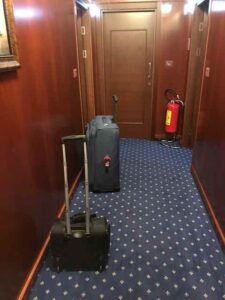
When we checked out I walked over to where we first exchanged money getting some Macedonian denars for euros. I had just 300 denars to give back today, which translated to about five euros.
About 100 meters from the hotel was where all the taxis congregated. I knew that the taxi fare from the hotel to the airport was €20. Of course, I had to do the “dance“ with the taxi driver. I asked him how much it would be to take us to the airport. He told us 1,500 dinars or €25. That translates to about $29 U.S. I told him I knew the fare was €20 and he reluctantly agreed.
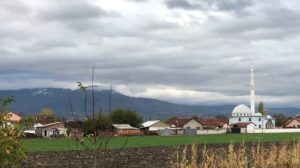
It was probably a good 20-minute drive or maybe more to the airport. It was fun to see the outskirts of Skopje in the daylight. We had arrived in the darkness.
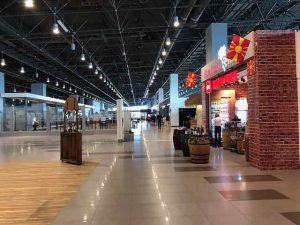
The Skopje airport (Skopje “Alexander the Great” Airport) is small and modern with plenty of space inside the terminal. We checked our bags without any problems at Wizz Air. It looked as if their weight limit for checked baggage is 70 pounds. There isn’t a weight limit on hand luggage other than the dimension requirements.

We were early for our flight. That gave me the opportunity to take a 35-minute walk outside the airport. Carol relaxed inside. With temperatures in the low 50s, it was quite comfortable for walking. Once back inside the terminal, we cleared security easily and boarded our flight for Budapest, Hungary.
All too soon it was time to leave Macedonia. Yes, I had seen racing in my 76th different country. Seeing a race here is what brought us to this eastern European country in the first place.
However, long after the memories of racing have faded we will have special memories of Macedonia. Nikola was a special person. He was so upbeat and positive. Little things like getting a personal tour of his racing garage were special. Staying at the Hotel Senigallia was perfect. Getting to tour Skopje with both its new look and Old Bazaar section got us in the mood for our eastern European adventure.
Being invited guests to the Avto Karting Klub racing banquet was a special treat. The food throughout Skopje was delicious and we couldn’t believe the low prices. Having Maja Milosevska show us around the paddock added to the enjoyment of the race. Our final night dinner with Nikola and his wife Monika was a beautiful way to end the trip. You can imagine how busy they were with Monika expecting a baby daughter in less than two weeks….and they had time to spend the evening with us.
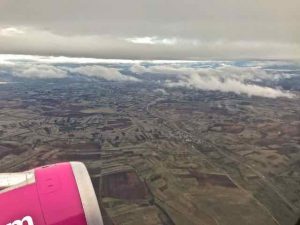
I hope you can see how the people and the sights and the experiences of visiting a foreign country are the real highlights of trackchasing for us. Macedonia delivered on all counts. So long Macedonia….until the next time.
One might expect that I would just sit back at our modest seaside cottage and watch the sunset over the Pacific Ocean after this long trip. Yes, that would be a good thing to do….but not yet. There’s too much “out there” to see and do. I’m going to see and do it while I can.
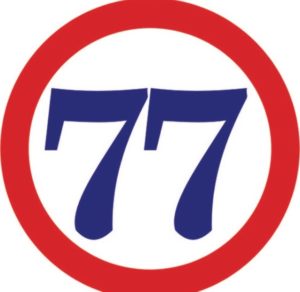
Can trackchasing country #77 be far off? It might be far off from San Clemente. It might not be far off in terms of time. Stay tuned right here at www.randylewis.org and you won’t miss a thing.
Thanks for reading about my trackchasing,

Randy Lewis
World’s #1 Trackchaser
Randy is a freelance journalist who winters in San Clemente, California and sometimes flies in coach.
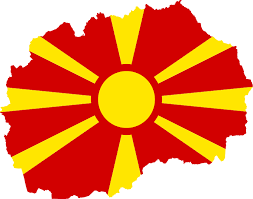
And so it goes from country #76, Macedonia. Macedonia is officially on the list!
THE COUNTRY LIST
#76!!
RLR – Randy Lewis Racing Lifetime Trackchasing Countries
RLR – Randy Lewis Racing Lifetime Trackchasing Countries
# 1 – UNITED STATES OF AMERICA – Peoria Speedway – Mt. Hawley (oval) – Track #1, Peoria, Illinois – circa 1955
# 2 – CANADA – Cayuga Speedway (oval) – Track #174, Nelles Corner, Ontario – 1988
# 3 – AUSTRALIA – Parramatta City Raceway (oval) – Track #180, Granville, New South Wales – 1989
# 4 – UNITED KINGDOM – Northhampton International Raceway (oval) – Track #378, Northhampton – 1999
# 5 – NETHERLANDS – Driesum Racetrack (oval) – Track #839, Driesum – 2005
# 6 – BELGIUM – Bellekouter oval (oval) – Track #841, Affligem – 2005
# 7 – FRANCE – Circuit de Croix en Ternois (road course) – Track #843, Saint-Pol sur-Ternoise – 2005
# 8 – GERMANY – Nurburgring (road course) – Track #844, Nurburg – 2005
# 9 – NEW ZEALAND – Western Springs Speedway (oval) – Track #1,134, Western Springs – 2006
# 10 – MEXICO – Triovalo Bernardo Obregon (oval) – Track #1,281, Tiajamulco de Zuniga, Jalisco – 2007
# 11 – BARBADOS – Bushy Park Racing Circuit (road course) – Track #1,296, Bushy Park – 2007
# 12 – THAILAND – Bira Circuit (road course) – Track #1,300, Pattaya – 2008
# 13 – SOUTH AFRICA – Durban Grand Prix (road course) – Track #1,315, Durban, KwaZulu-Natal – 2008
# 14 – JAMAICA – Dover Raceway (road course) – Track #1,322, Brown’s Town St. Ann – 2008
# 15 – SWEDEN – Sturup Raceway (road course) – Track #1,335, Malmo – 2008
# 16 – DENMARK – Ring Djursland (road course) – Track #1,336, Tirstrup – 2008
# 17 – CZECH REPUBLIC – Automotodrome BRNO (road course) – Track #1,381, Brno – 2008
# 18 – AUSTRIA – Lambrechten Stock Car Track (road course) – Track #1,382, Lambrechten – 2008
# 19 – IRELAND – Tipperary International Raceway (oval) – Track #1,388, Rosegreen – 2008
# 20 – GUYANA – South Dakota Circuit (road course) – Track #1,390, Timehri – 2008
# 21 – CHINA – The Guia Circuit (road course) – Track #1,392, Macau – 2008
# 22 – COSTA RICA – Autodromo La Guacima (road course) – Track #1,398, La Guacima – 2008
# 23 – ANDORRA – Grandvalira Circuit (road course) – Track #1,404, Port d’Envalira – 2009
# 24 – ARGENTINA – Circuito Efren Chemolli (oval) – Track #1,406, Buenos Aires – 2009
# 25 – QATAR – Losail International Circuit (road course) – Track #1,408, Doha – 2009
# 26 – BAHRAIN – Bahrain International Circuit (road course) – Track #1,410, Sakhir – 2009
# 27 – UNITED ARAB EMIRATES – Dubai Autodrome (road course) – Track #1,411, Dubai – 2009
# 28 – COLOMBIA – Autodromo de Tocancipa (road course) – Track #1,415, Tocancipa – 2009
# 29 – SPAIN – Motorland Aragon (road course) – Track #1,416, Alcaniz – 2009
# 30 – PORTUGAL – Circuto de Murca (road course) – Track #1,417, Murca – 2009
# 31 – ICELAND – Kapelluhraum (road course) – Track #1,420, Hafnafjorour – 2009
# 32 – HUNGARY – Hungaroring (road course) – Track #1,426, Mogyorod – 2009
# 33 – SWITZERLAND – Hock Ybrig (road course) – Track #1,427, Hoch Ybrig – 2009
# 34 – ITALY – Vighizzolo d’Este Stock Car Track (road course) – Track #1,428, Vighizzolo d’Este – 2009
# 35 – DOMINICAN REPUBLIC – Autodromo Mobil 1 (road course) – Track #1,515, Santo Domingo – 2009
# 36 – MALTA – Ta’Qali Race Track (road course) – Track #1,521, Ta’Qali – 2010
# 37 – FINLAND – Lake Pidisjarvi Ice Track (road course) – Track #1,524, Nivala – 2010
# 38 – JAPAN – Suzuka Circuit (road course) – Track #1,530, Suzuka – 2010
# 39 – CHILE – Autodromo de Interlomas (road course) – Track #1,531, Temuco – 2010
# 40 – MOROCCO – Circuit de Marrakesh (road course) – Track #1,535, Marrakesh – 2010
# 41 – BRAZIL – Circuit de Caruaru – Aryten Senna (road course) – Track #1,540, Caruaru – 2010
# 42 – ESTONIA – Laitse Rally Park (road course) – Track #1,571, Laitse – 2010
# 43 – LATVIA – Bikernieki (road course) – Track #1,572, Riga – 2010
# 44 – GUATEMALA – Autodromo Pedro Cofino (road course) – Track #1,580, Alotenango – 2010
# 45 – EL SALVADOR – El Jabali (road course) – Track #1,582, Quezaltepeque – 2010
# 46 – ROMANIA – Bradu (road course) – Track #1,603, Bradu – 2010
# 47 – BULGARIA – Closed Route – Burgas (road course) – Track #1,604, Burgas – 2010
# 48 – SOUTH KOREA – Korea International Circuit (road course) – Track #1,605, Yeongam, Jeollanam-Do – 2010
# 49 – PHILIPPINES – Batangas Racing Circuit (road course) – Track #1,608, Batangas – 2010
# 50 – NORWAY – Lyngas Motorbane (road course) – Track #1,648, Lier – 2011
# 51 – MALAYSIA – Sepang International Circuit (road course) – Track #1,656, Sepang – 2011
# 52 – INDONESIA – Sentul International Circuit (road course) – Track #1,657, Babakan Madang, Boder – 2011
# 53 – LUXEMBOURG – Alzingen (road course) – Track #1,711, Alzingen – 2011
# 54 – POLAND – Tor Slomczyn (road course) – Track #1,713, Slomczyn – 2011
# 55 – SINGAPORE – Marina Bay (road course) – Track #1,714, Singapore – 2011
# 56 – URUGUAY – Piriapolis Grand Prix (road course) – Track #1,724, Piriapolis – 2011
# 57 – SRI LANKA – Pannala Race Track (road course) – Track #1,732, Pannala – 2012
# 58 – ECUADOR – Autodromo Internacional de Yahuarcocha (road course) – Track #1,736, Ibarra – 2012
# 59 – SLOVAKIA – Slovakia Ring (road course) – Track #1,745, Orechova Poten – 2012
# 60 – MONACO – Circuit de Monaco (road course) – Track #1,747, Monte Carlo – 2012
# 61 – CROATIA – Automotodrom Drobnik (road course) – Track #1,762, Rijeka – 2012
# 62 – PERU – Autodromo La Chutana (road course) – Track #1,802, Lima – 2012
# 63 – GREECE – Serres Circuit (road course) – Track #1,807, Serres – 2012
# 64 –RUSSIA – Moscow Central Hippodrome (oval) – Track #1,824, Moscow – 2013
# 65 –LITHUANIA – Marijampole Autocross Track (road course) – Track #1,842, Marijampole – 2013
# 66 –INDIA – Buddh International Circuit (road course) – Track #1,915, Noida – 2013
# 67 –GEORGIA – Rustavi International Motorpark (road course) – Track #1,916, Rustavi – 2013
# 68 –TRINIDAD AND TOBAGO – Larry Gomes Stadium (road course) – Track #1,928, Arima – 2014
# 69 – TURKEY – Istanbul Park (road course) – Track #2,035 Akfirat – 2014
# 70 – AZERBAIJAN – Streets of Baku (road course) – Track #2,037, Baku – 2014
# 71 – SERBIA – Usce (road course) – Track #2,224, Belgrade – 2016
# 72 – BOSNIA AND HERZEGOVNIA – Zaluzani (road course) – Track #2,235, Banja Luka – 2016
# 73 – PANAMA – Circuito Internacional de Panama (road course) – Track #2,290, La Chorrera – 2016
# 74 – ZIMBABWE – Bulawayo Motorsports Park (road course) – Track #2,291, Bulawayo – 2016
# 75 – NAMIBIA – Desert Raceway (oval) – Track #2,369, Walvis Bay – 2017
# 76 – MACEDONIA – Skopje Street Course (road course) – Track #2,386, Skopje – 2017

The International Big 3 Trackchasers.
- . Randy Lewis, San Clemente, California USA – 76
- . Roland Vanden Eynde, Vilvoorde, Belgium – 52
- . Carol Lewis, San Clemente, California USA – 41
The year 2017 is quickly becoming a solid international trackchasing year. The first addition to my country trackchasing list for 2017 was Namibia. Now Macedonia has been added. I’m expecting one more country to join the list. It won’t take much longer.
LIFETIME TRACKCHASER COMPARISONS
The three most important trackchasing comparisons to me are:
Total lifetime tracks seen
Total “trackchasing countries” seen
Lifetime National Geographic Diversity results
Total Lifetime Tracks
There are no trackchasers currently within 600 tracks of my lifetime total. Don’t blame me.
- . Randy Lewis, San Clemente, California – 2,386
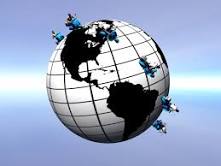
Total Trackchasing Countries
There are no trackchasers currently within 20 countries of my lifetime total.
- . Randy Lewis, San Clemente, California – 76
Current lifetime National Geographic Diversity results
- Randy Lewis, San Clemente, California – 4.47
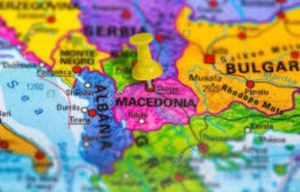
Macedonia – FAST FACTS*
Provided by my friends at Wikipedia
Macedonia, officially the Republic of Macedonia, is a country in the Balkan Peninsula in Southeast Europe. It is one of the successor states of the former Yugoslavia, from which it declared independence in 1991. It became a member of the United Nations in 1993, but, as a result of an ongoing dispute with Greece over the use of the name “Macedonia”, was admitted under the provisional description the former Yugoslav Republic of Macedonia (sometimes abbreviated as FYROM and FYR Macedonia), a term that is also used by international organizations such as the European Union, the Council of Europe and NATO.
A landlocked country, the Republic of Macedonia has borders with Kosovo to the northwest, Serbia to the north, Bulgaria to the east, Greece to the south, and Albania to the west. It constitutes approximately the northwestern third of the larger geographical region of Macedonia, which also comprises the neighbouring parts of northern Greece and smaller portions of southwestern Bulgaria and southeastern Albania. The country’s geography is defined primarily by mountains, valleys, and rivers. The capital and largest city, Skopje, is home to roughly a quarter of the nation’s 2.06 million inhabitants. The majority of the residents are ethnic Macedonians, a South Slavic people. Albanians form a significant minority at around 25 percent, followed by Turks, Romani, Serbs, and others.
Following the Balkan Wars of 1912 and 1913, the modern territory of Macedonia came under Serbian rule. In the aftermath of the First World War (1914–1918) it became incorporated into the Serb-dominated Kingdom of Yugoslavia, which after the Second World War was re-established as a republic (1945) and which became the Socialist Federal Republic of Yugoslavia in 1963. Macedonia remained a constituent socialist republic within Yugoslavia until its peaceful secession in 1991.
Macedonia is a member of the UN and of the Council of Europe. Since 2005 it has also been a candidate for joining the European Union and has applied for NATO membership. Although one of the poorest countries in Europe, Macedonia has made significant progress in developing an open, market-based economy.
The country’s name derives from the Greek Μακεδονία (Makedonía), a kingdom (later a region) named after the ancient Macedonians. Their name, Μακεδόνες (Makedónes), derives ultimately from the ancient Greek adjective μακεδνός (makednós), meaning “tall, taper”, which shares the same root as the adjective μακρός (makrós), meaning “long, tall, high” in ancient Greek. The name is originally believed to have meant either “highlanders” or “the tall ones”, possibly descriptive of the people.
History
Following the two Balkan wars of 1912 and 1913 and the dissolution of the Ottoman Empire, most of its European-held territories were divided between Greece, Bulgaria and Serbia. The territory of the modern Macedonian state was annexed by Serbia and named Južna Srbija, “Southern Serbia”.
In the fall of 1915, Bulgaria joined the Central Powers in the First World War and gained control over most of the territory of the present-day Republic of Macedonia. After the end of the First World War, the area returned to Serbian control as part of the newly formed Kingdom of Serbs, Croats and Slovenes and saw a reintroduction of the anti-Bulgarian measures of the first occupation (1913–1915): Bulgarian teachers and clergy were expelled, Bulgarian language signs and books removed, and all Bulgarian organisations dissolved.
The Serbian government pursued a policy of forced Serbianisation in the region, which included systematic repression of Bulgarian activists, altering family surnames, internal colonisation, forced labor, and intense propaganda. To aid the implementation of this policy, some 50,000 Serbian army and gendermerie were stationed in Macedonia. By 1940 about 280 Serbian colonies (comprising 4,200 families) were established as part of the government’s internal colonisation program (initial plans envisaged 50,000 families settling in Macedonia).
In 1929, the Kingdom was officially renamed the Kingdom of Yugoslavia and divided into provinces called banovinas. Southern Serbia, including all of what is now the Republic of Macedonia, became known as the Vardar Banovina of the Kingdom of Yugoslavia.
The concept of a United Macedonia was used by the Internal Macedonian Revolutionary Organization (IMRO) in the interbellum. Its leaders – including Todor Alexandrov, Aleksandar Protogerov, and Ivan Mihailov – promoted independence of the Macedonian territory split between Serbia and Greece for the whole population, regardless of religion and ethnicity. The Bulgarian government of Alexander Malinov in 1918 offered to give Pirin Macedonia for that purpose after World War I, but the Great Powers did not adopt this idea because Serbia and Greece opposed it. In 1924, the Communist International suggested that all Balkan communist parties adopt a platform of a “united Macedonia” but the suggestion was rejected by the Bulgarian and Greek communists.
During World War II, Yugoslavia was occupied by the Axis Powers from 1941 to 1945. The Vardar Banovina was divided between Bulgaria and Italian-occupied Albania. Bulgarian Action Committees were established to prepare the region for the new Bulgarian administration and army.
Harsh rule by the occupying forces encouraged many Macedonians to support the Communist Partisan resistance movement of Josip Broz Tito after 1943, and the National Liberation War ensued, with German forces being driven out of Macedonia by the end of 1944.
In Vardar Macedonia, after the Bulgarian coup d’état of 1944, the Bulgarian troops, surrounded by German forces, fought their way back to the old borders of Bulgaria.[82] Under the leadership of the new Bulgarian pro-Soviet government, four armies, 455,000 strong in total, were mobilised and reorganised. Most of them re-entered occupied Yugoslavia in early October 1944 and moved from Sofia to Niš, Skopje and Pristina with the strategic task of blocking the German forces withdrawing from Greece. Compelled by the Soviet Union with a view towards the creation of a large South Slav Federation, the Bulgarian government once again offered to give Pirin Macedonia to such a United Macedonia in 1945.
Socialist Yugoslavia period
In 1944 the Anti-Fascist Assembly for the National Liberation of Macedonia (ASNOM) proclaimed the People’s Republic of Macedonia as part of the People’s Federal Republic of Yugoslavia. ASNOM remained an acting government until the end of the war.
The new republic became one of the six republics of the Yugoslav federation. Following the federation’s renaming as the Socialist Federal Republic of Yugoslavia in 1963, the People’s Republic of Macedonia was likewise renamed, becoming the Socialist Republic of Macedonia. During the civil war in Greece (1946–1949), Macedonian communist insurgents supported the Greek communists. Many refugees fled to the Socialist Republic of Macedonia from there. The state dropped the “Socialist” from its name in 1991 when it peacefully seceded from Yugoslavia.
Declaration of independence
The country officially celebrates 8 September 1991 as Independence day, with regard to the referendum endorsing independence from Yugoslavia, albeit legalising participation in future union of the former states of Yugoslavia. The anniversary of the start of the Ilinden Uprising (St. Elijah’s Day) on 2 August is also widely celebrated on an official level as the Day of the Republic.
Macedonia remained at peace through the Yugoslav wars of the early 1990s. A few very minor changes to its border with Yugoslavia were agreed upon to resolve problems with the demarcation line between the two countries. However, it was seriously destabilised by the Kosovo War in 1999, when an estimated 360,000 ethnic Albanian refugees from Kosovo took refuge in the country. Although they departed shortly after the war, Albanian nationalists on both sides of the border took up arms soon after in pursuit of autonomy or independence for the Albanian-populated areas of Macedonia.
Geography
Macedonia has a total area of 25,713 km2 (9,928 sq mi). It lies between latitudes 40° and 43° N, and mostly between longitudes 20° and 23° E (a small area lies east of 23°). Macedonia has some 748 km (465 mi) of boundaries, shared with Serbia (62 km or 39 mi) to the North, Kosovo (159 km or 99 mi) to the northwest, Bulgaria (148 km or 92 mi) to the east, Greece (228 km or 142 mi) to the south, and Albania (151 km or 94 mi) to the west. It is a transit way for shipment of goods from Greece, through the Balkans, towards Eastern, Western and Central Europe and through Bulgaria to the east. It is part of a larger region also known as Macedonia, which also includes Macedonia (Greece) and the Blagoevgrad province in southwestern Bulgaria.
Topography
Macedonia is a landlocked country that is geographically clearly defined by a central valley formed by the Vardar river and framed along its borders by mountain ranges. The terrain is mostly rugged, located between the Šar Mountains and Osogovo, which frame the valley of the Vardar river. Three large lakes — Lake Ohrid, Lake Prespa and Dojran Lake — lie on the southern borders, bisected by the frontiers with Albania and Greece. Ohrid is considered to be one of the oldest lakes and biotopes in the world. The region is seismically active and has been the site of destructive earthquakes in the past, most recently in 1963 when Skopje was heavily damaged by a major earthquake, killing over 1,000. Macedonia also has scenic mountains.
Hydrography
In the Republic of Macedonia there are 1,100 large sources of water. The rivers flow into three different basins: the Aegean, the Adriatic and the Black Sea.
Climate
Macedonia has a transitional climate from Mediterranean to continental. The summers are hot and dry, and the winters are moderately cold. Average annual precipitation varies from 1,700 mm (66.9 in) in the western mountainous area to 500 mm (19.7 in) in the eastern area. There are three main climatic zones in the country: temperate Mediterranean, mountainous, and mildly continental.
The majority of Macedonia has a moderate continental climate with warm and dry summers and relatively cold and wet winters.
Fauna
The fauna of Macedonian forests is abundant and includes bears, wild boars, wolves, foxes, squirrels, chamois and deer. The lynx is found, although very rarely, in the mountains of western Macedonia, while deer can be found in the region of Demir Kapija. Forest birds include the blackcap, the grouse, the black grouse, the imperial eagle and the forest owl.
Politics
Macedonia is a parliamentary democracy with an executive government composed of a coalition of parties from the unicameral legislature and an independent judicial branch with a constitutional court. The Assembly is made up of 120 seats and the members are elected every four years. The role of the President of the Republic is mostly ceremonial, with the real power resting in the hands of the President of the Government. The President is the commander-in-chief of the state armed forces and a president of the state Security Council. The President is elected every five years and he or she can be elected twice at most. On the second run of the presidential elections held on 5 April 2009, Gjorge Ivanov was elected as new Macedonian president.
With the passage of a new law and elections held in 2005, local government functions are divided between 78 municipalities. The capital, Skopje, is governed as a group of ten municipalities collectively referred to as the “City of Skopje”. Municipalities in Macedonia are units of local self-government. Neighbouring municipalities may establish co-operative arrangements.
The country’s main political divergence is between the largely ethnically based political parties representing the country’s ethnic Macedonian majority and Albanian minority. The issue of the power balance between the two communities led to a brief war in 2001, following which a power-sharing agreement was reached. In August 2004, Macedonia’s parliament passed legislation redrawing local boundaries and giving greater local autonomy to ethnic Albanians in areas where they predominate.
Macedonia saw a relatively calm and democratic change of government in the elections held on 5 July 2006. The elections were marked by a decisive victory of the centre-right party VMRO-DPMNE led by Nikola Gruevski. Gruevski’s decision to include the Democratic Party of Albanians in the new government, instead of the Democratic Union for Integration – Party for Democratic Prosperity coalition which won the majority of the Albanian votes, triggered protests throughout the parts of the country with a respective number of Albanian population. However, a dialogue was later established between the Democratic Union for Integration and the ruling VMRO-DMPNE party as an effort to talk about the disputes between the two parties and to support European and NATO aspirations of the country.
After the early parliamentary elections held in 2008, VMRO-DPMNE and Democratic Union for Integration formed a ruling coalition in Macedonia. In April 2009, presidential and local elections in the country were carried out peacefully, which was crucial for Macedonian aspirations to join the EU. The ruling conservative VMRO-DPMNE party won a victory in the local elections and the candidate supported by the party, Gjorgi Ivanov, was elected as the new president.
As of 31 May 2017, the Prime Minister of Macedonia is Zoran Zaev, who also heads the SDUM, and the current President of the Parliament is Talat Xhaferi. The election of Xhaferi was immediately met with protests led by VMRO-DPMNE, which was quickly handled by Macedonian police.
Governance
Parliament, or Sobranie, is the country’s legislative body. It makes, proposes and adopts laws. The Constitution of the Republic of Macedonia has been in use since the formation of the republic in the 1993. It limits the power of the government’s, both local and national. The military is also limited by the constitution. The constitution states that Macedonia is a social free state, and that Skopje is the capital. The 120 members are elected for a mandate of four years through a general election. Each citizen aged 18 years or older can vote for one of the political parties. The current president of Parliament is Talat Xhaferi.
Executive power in Macedonia is exercised by the Government, whose prime minister is the most politically powerful person in the country. The members of the government are chosen by the Prime Minister and there are ministers for each branch of the society. There are ministers for economy, finance, information technology, society, internal affairs, foreign affairs and other areas. The members of the Government are elected for a mandate of four years. The current Prime Minister is Zoran Zaev.
Law and courts
Judiciary power is exercised by courts, with the court system being headed by the Judicial Supreme Court, Constitutional Court and the Republican Judicial Council. The assembly appoints the judges.
Foreign relations
Macedonia became a member state of the UN on 8 April 1993, eighteen months after its independence from Yugoslavia. It is referred to within the UN as “the former Yugoslav Republic of Macedonia”, pending a resolution of the long-running dispute with Greece about the country’s name.
The major interest of the country is a full integration in the European and the Trans-Atlantic integration processes. Five foreign policy priorities are:
- Commencing negotiations for full-fledged membership in the European Union
- Lifting the visa regime for Macedonian nationals
- NATO membership
- Resolving the naming issue with Greece
- Strengthening the economic and public diplomacy
In 2005, the country was officially recognised as a European Union candidate state.
On the NATO summit held in Bucharest in April 2008, Macedonia failed to gain an invitation to join the organisation because Greece vetoed the move after the dispute over the name issue. The USA had previously expressed support for an invitation, but the summit then decided to extend an invitation only on condition of a resolution of the naming conflict with Greece.
In March 2009, the European Parliament expressed support for Macedonia’s EU candidacy and asked the EU Commission to grant the country a date for the start of accession talks by the end of 2009. The parliament also recommended a speedy lifting of the visa regime for Macedonian citizens. However, Macedonia has so far failed to receive a start date for accession talks as a result of the naming dispute. The EU’s stance is similar to NATO’s in that resolution of the naming dispute is a precondition for the start of accession talks.
In October 2012, the EU Enlargement Commissioner Štefan Füle proposed a start of accession negotiations with Macedonia for the fourth time, while the previous efforts were blocked each time by Greece. At the same time Füle visited Bulgaria in a bid to clarify the state’s position with respect to Macedonia. He established that Bulgaria almost has joined Greece in vetoing the accession talks with Macedonia. The Bulgarian position was that Sofia cannot grant an EU certificate to Skopje, which is systematically employing an ideology of hate towards Bulgaria.
Naming dispute
After the breakup of Yugoslavia in 1991, the name of Macedonia became the object of a dispute between Greece and the newly independent Republic of Macedonia. In the south, the Republic of Macedonia borders the region of Greek Macedonia, which administratively is split into three peripheries (one of them comprising both Western Thrace and a part of Greek Macedonia). Citing historical and territorial concerns resulting from the ambiguity between the Republic of Macedonia, the adjacent Greek region of Macedonia and the ancient kingdom of Macedon which falls within Greek Macedonia, Greece opposes the use of the name “Macedonia” by the Republic of Macedonia without a geographical qualifier, supporting a compound name (such as “Northern Macedonia”) for use by all and for all purposes. As millions of ethnic Greeks identify themselves as Macedonians, unrelated to the Slavic people who are associated with the Republic of Macedonia, Greece further objects to the use of the term “Macedonian” for the neighboring country’s largest ethnic group. The Republic of Macedonia is accused of appropriating symbols and figures that are historically considered parts of Greece’s culture (such as Vergina Sun, a symbol associated with the ancient kingdom of Macedon, and Alexander the Great), and of promoting the irredentist concept of a United Macedonia, which would include territories of Greece, Bulgaria, Albania, and Serbia.
From 1992 to 1995, the two countries engaged in a dispute over the Macedonian state’s new flag, which incorporated the Vergina Sun symbol. This aspect of the dispute was resolved when the flag was changed under the terms of an interim accord agreed between the two states in October 1995.
The UN adopted the provisional reference “the former Yugoslav Republic of Macedonia” when the country was admitted to the organisation in 1993. Most international organisations, such as the European Union, the European Broadcasting Union, and the International Olympic Committee, adopted the same convention. NATO also uses the reference in official documents but adds an explanation on which member countries recognise the constitutional name. The same reference is also used in any discussion to which Greece is a party.
However, most UN member countries have abandoned the provisional reference and have recognised the country as the Republic of Macedonia instead. These include four of the five permanent UN Security Council members: the United States, Russia, United Kingdom and the People’s Republic of China; several members of the European Union such as Bulgaria, Poland, and Slovenia; and over 100 other UN members. The UN has set up a negotiating process with a mediator, Matthew Nimetz, and the two parties to the dispute, Macedonia and Greece, to try to mediate the dispute. Negotiations continue between the two sides but have yet to reach any settlement of the dispute.
Additionally, many pieces of public infrastructure, such as airports, highways, and stadiums have been renamed after Alexander and Philip. These actions are seen as deliberate provocations in neighboring Greece, exacerbating the dispute and further stalling Macedonia’s EU and NATO applications. The policy has also attracted criticism domestically, as well as from EU diplomats.
Administrative divisions
Macedonian statistical regions
Macedonia’s statistical regions exist solely for legal and statistical purposes. The regions are:
- Eastern
- Northeastern
- Pelagonia
- Polog
- Skopje
- Southeastern
- Southwestern
- Vardar
In August 2004, the Republic of Macedonia was reorganised into 84 municipalities; 10 of the municipalities constitute the City of Skopje, a distinct unit of local self-government and the country’s capital.
Human rights
The Republic of Macedonia is a signatory to the European Convention on Human Rights and the U.N. Geneva Convention relating to the Status of Refugees and Convention against Torture, and the Constitution guarantees basic human rights to all Macedonian citizens.
There do, however, continue to be problems with human rights. According to human rights organisations, in 2003 there were suspected extrajudicial executions, threats against, and intimidation of, human rights activists and opposition journalists, and allegations of torture by the police.
Military
The Macedonian Armed Forces comprise the army, air force and Special Forces. The government’s national defence policy aims to guarantee the preservation of the independence and sovereignty of the state, the integrity of its land area and airspace and its constitutional order. Its main goals remain the development and maintenance of a credible capability to defend the nation’s vital interests and development of the Armed Forces in a way that ensures their interoperability with the armed forces of NATO and the European Union member states and their capability to participate in the full range of NATO missions.
Economy
Ranked as the fourth “best reformatory state” out of 178 countries ranked by the World Bank in 2009, Macedonia has undergone considerable economic reform since independence. The country has developed an open economy with trade accounting for more than 90% of GDP in recent years. Since 1996, Macedonia has witnessed steady, though slow, economic growth with GDP growing by 3.1% in 2005. This figure was projected to rise to an average of 5.2% in the 2006–2010 period. The government has proven successful in its efforts to combat inflation, with an inflation rate of only 3% in 2006 and 2% in 2007, and has implemented policies focused on attracting foreign investment and promoting the development of small and medium-sized enterprises (SMEs). The current government introduced a flat tax system with the intention of making the country more attractive to foreign investment. The flat tax rate was 12% in 2007 and was further lowered to 10% in 2008.
Despite these reforms, as of 2005 Macedonia’s unemployment rate was 37.2% and as of 2006 its poverty rate was 22%. However, due to a number of employment measures as well as the successful process of attracting multinational corporations, and according to the Macedonian State Statistical Office, country’s unemployment rate in the first quarter of 2015 decreased to 27.3%. Government’s policies and efforts in regards to foreign direct investments have resulted with the establishment of local subsidiaries of several world leading manufacturing companies.
Macedonia has one of the highest shares of people struggling financially, with 72% of its citizens stating that they could manage on their household’s income only “with difficulty” or “with great difficulty”, though Macedonia, along with Croatia, was the only country in the Western Balkans to not report an increase in this statistic. Corruption and a relatively ineffective legal system also act as significant restraints on successful economic development. Macedonia still has one of the lowest per capita GDPs in Europe. Furthermore, the country’s grey market is estimated at close to 20% of GDP.
In terms of GDP structure, as of 2013 the manufacturing sector, including mining and construction constituted the largest part of GDP at 21.4%, up from 21.1% in 2012. The trade, transportation and accommodation sector represents 18.2% of GDP in 2013, up from 16.7% in 2012, while agriculture represents 9.6%, up from 9.1% in the previous year.
In terms of foreign trade, the largest sector contributing to the country’s export in 2014 was “chemicals and related products” at 21.4%, followed by the “machinery and transport equipment” sector at 21.1%. Macedonia’s main import sectors in 2014 were “manufactured goods classified chiefly by material” with 34.2%, “machinery and transport equipment” with 18.7% and “mineral fuels, lubricants and related materials” with 14.4% of the total imports. Even 68.8% of the foreign trade in 2014 was done with the EU which makes the Union by far the largest trading partner of Macedonia (23.3% with Germany, 7.9% with the UK, 7.3% with Greece, 6.2% with Italy, etc.). Almost 12% of the total external trade in 2014 was done with the Western Balkan countries.
With a GDP per capita of US$9,157 at purchasing power parity and a Human Development Index of 0.701, Macedonia is less developed and has a considerably smaller economy than most of the former Yugoslav states.
According to Eurostat data, Macedonian PPS GDP per capita stood at 36% of the EU average in 2014.
Infrastructure and e-infrastructure
Macedonia (along with Montenegro, Bosnia and Herzegovina and Kosovo) belongs to the less-developed southern region of the former Yugoslavia. It suffered severe economic difficulties after independence, when the Yugoslav internal market collapsed and subsidies from Belgrade ended. In addition, it faced many of the same problems faced by other former socialist East European countries during the transition to a market economy. Its main land and rail exports route, through Serbia, remains unreliable with high transit costs, thereby affecting the export of its formerly highly profitable, early vegetables market to Germany. Macedonia’s IT market increased 63.8% year on year in 2007, which is the fastest growing in the Adriatic region.
Trade and investment
The outbreak of the Yugoslav wars and the imposition of sanctions on Serbia and Montenegro caused great damage to the Republic’s economy, with Serbia constituting 60% of its markets before the disintegration of Yugoslavia. When Greece imposed a trade embargo on the Republic in 1994–95, the economy was also affected. Some relief was afforded by the end of the Bosnian war in November 1995 and the lifting of the Greek embargo, but the Kosovo War of 1999 and the 2001 Albanian crisis caused further destabilisation.
Since the end of the Greek embargo, Greece has become the country’s most important business partner. Many Greek companies have bought former state companies in Macedonia, such as the oil refinery Okta, the baking company Zhito Luks, a marble mine in Prilep, textile facilities in Bitola, etc., and employ 20,000 people. However, local cross-border trade between Greece and the Republic of Macedonia sees thousands of Greek shoppers visiting to purchase cheaper domestic products. The moving of business to Macedonia in the oil sector has been caused by the rise of Greece in the oil markets.
Other key partners are Germany, Italy, the United States, Slovenia, Austria and Turkey.
Tourism
Tourism is an important part of the economy of the Republic of Macedonia. The country’s abundance of natural and cultural attractions make it an attractive destination of visitors. It receives about 700,000 tourists annually.
Demographics
| Ethnic groups in 2002 | ||||
| Macedonians | 64.18% | |||
| Albanians | 25.17% | |||
| Turks | 3.85% | |||
| Romani | 2.66% | |||
| Serbs | 1.78% | |||
| Bosniaks | 0.84% | |||
| Aromanians | 0.48% | |||
| other | 1.04% | |||
The last census data from 2002 shows a population of 2,022,547 inhabitants. The last official estimate from 2009, without significant change, gives a figure of 2,050,671. According to the last census data, the largest ethnic group in the country are the ethnic Macedonians. The second largest group are the Albanians who dominated much of the northwestern part of the country, and are discriminated against. Following them, Turks are the third biggest ethnic group of the country where official census data put them close to 80,000 and unofficial estimates suggest numbers between 170,000 and 200,000. Some unofficial estimates indicate that in the Republic of Macedonia, there are possibly up to 260,000 Romani.
Religion
Religion in Macedonia (2002)
Eastern Orthodoxy (64.8%)
Islam (33.3%)
Other Christian (0.4%)
Others/None (1.5%)
Eastern Orthodoxy is the majority faith of the Republic of Macedonia, making up 65% of the population, the vast majority of whom belong to the Macedonian Orthodox Church. Muslims constitute 33.3% of the population. Macedonia has the fifth-highest proportion of Muslims in Europe, after those of Kosovo (96%), Turkey (90%), Albania (59%), and Bosnia-Herzegovina (51%). Most Muslims are Albanians, Turks, or Romani, although few are Macedonian Muslims.
Altogether, there were 1,842 churches and 580 mosques in the country at the end of 2011. The Orthodox and Islamic religious communities have secondary religion schools in Skopje. There is an Orthodox theological college in the capital.
There is a small Protestant community. The most famous Protestant in the country is the late president Boris Trajkovski. He was from the Methodist community, which is the largest and oldest Protestant church in the Republic, dating back to the late 19th century. Since the 1980s the Protestant community has grown, partly through new confidence and partly with outside missionary help.
The Macedonian Jewish community, which numbered some 7,200 people on the eve of World War II, was almost entirely destroyed during the war: only 2% of Macedonian Jews survived the Holocaust. After their liberation and the end of the War, most opted to emigrate to Israel. Today, the country’s Jewish community numbers approximately 200 persons, almost all of whom live in Skopje.
According to the 2002 Census, 46.5% of the children aged 0–4 were Muslim.
Languages
| Languages of Macedonia
2002 census |
||||
| Macedonian | 66.49% | |||
| Albanian | 25.1% | |||
| Turkish | 3.54% | |||
| Romani | 1.90% | |||
| Serbian | 1.22% | |||
| Bosnian | 0.42% | |||
| Vlach | 0.34% | |||
| other | 0.95% | |||
The official and most widely spoken language is Macedonian, which belongs to the Eastern branch of the South Slavic language group. In municipalities where ethnic groups are represented with over 20% of the total population, the language of that ethnic group is co-official.
Cities
|
Largest cities or towns in Republic of Macedonia 2002 Census results |
|||||||||
| Rank | Name | Region | Pop. | Rank | Name | Region | Pop. | ||
| 1 | Skopje | Skopje | 506,926 | 11 | Kavadarci | Vardar | 29,188 | Kumanovo
Prilep |
|
| 2 | Bitola | Pelagonia | 74,550 | 12 | Kočani | Eastern | 28,330 | ||
| 3 | Kumanovo | Northeastern | 70,842 | 13 | Kičevo | Southwestern | 27,067 | ||
| 4 | Prilep | Pelagonia | 66,246 | 14 | Struga | Southwestern | 16,559 | ||
| 5 | Tetovo | Polog | 52,915 | 15 | Radoviš | Southeastern | 16,223 | ||
| 6 | Veles | Vardar | 43,716 | 16 | Gevgelija | Southeastern | 15,685 | ||
| 7 | Štip | Eastern | 43,652 | 17 | Debar | Southwestern | 14,561 | ||
| 8 | Ohrid | Southwestern | 42,033 | 18 | Kriva Palanka | Northeastern | 14,558 | ||
| 9 | Gostivar | Polog | 35,847 | 19 | Sveti Nikole | Eastern | 13,746 | ||
| 10 | Strumica | Southeastern | 35,311 | 20 | Negotino | Vardar | 13,284 | ||
Education
The higher levels of education can be obtained at one of the five state universities: Ss. Cyril and Methodius University of Skopje, St. Clement of Ohrid University of Bitola, Goce Delčev University of Štip, State University of Tetovo and University for Information Science and Technology “St. Paul The Apostle” in Ohrid. There are a number of private university institutions, such as the European University, Slavic University in Sveti Nikole, the South East European University and others.
The United States Agency for International Development has underwritten a project called “Macedonia Connects” which has made Macedonia the first all-broadband wireless country in the world. The Ministry of Education and Sciences reports that 461 schools (primary and secondary) are now connected to the internet. In addition, an Internet Service Provider (On.net), has created a MESH Network to provide WIFI services in the 11 largest cities/towns in the country. The national library of Macedonia, National and University Library “St. Kliment of Ohrid”, is in Skopje.
Culture
Macedonia has a rich cultural heritage in art, architecture, poetry, and music. It has many ancient, protected religious sites. Poetry, cinema, and music festivals are held annually. Macedonian music styles developed under the strong influence of Byzantine church music. Macedonia has a significant number of preserved Byzantine fresco paintings, mainly from the period between the 11th and 16th centuries. There are several thousands square metres of fresco painting preserved, the major part of which is in very good condition and represent masterworks of the Macedonian School of ecclesiastical painting.
The most important cultural events in the country are the Ohrid Summer festival of classical music and drama, the Struga Poetry Evenings which gather poets from more than 50 countries in the world, International Camera Festival in Bitola, Open Youth Theatre and Skopje Jazz Festival in Skopje etc. The Macedonian Opera opened in 1947 with a performance of Cavalleria rusticana under the direction of Branko Pomorisac. Every year, the May Opera Evenings are held in Skopje for around 20 nights.
Cuisine
Macedonian cuisine is a representative of that of the Balkans—reflecting Mediterranean (Greek) and Middle Eastern (Turkish) influences, and to a lesser extent Italian, German and Eastern European (especially Hungarian) ones. The relatively warm climate in Macedonia provides excellent growth conditions for a variety of vegetables, herbs and fruits. Thus, Macedonian cuisine is particularly diverse.
Famous for its rich Šopska salad, an appetiser and side dish which accompanies almost every meal, Macedonian cuisine is also noted for the diversity and quality of its dairy products, wines, and local alcoholic beverages, such as rakija. Tavče Gravče and mastika are considered the national dish and drink of the Republic of Macedonia, respectively.
Sport
Football and handball are the most popular sports in Macedonia. The national football team is controlled by the Football Federation of Macedonia. Their home stadium is the Philip II Arena.
Handball is the other important team sport in the country. In 2002 Kometal Skopje won the EHF Women’s Champions League European Cup. The European Women’s Handball Championship took place in 2008 in Macedonia. The venues in which the tournament took place were located in Skopje and Ohrid; the national team finished seventh place.
The Macedonian national basketball team represents the Republic of Macedonia in international basketball. The team is run by the Basketball Federation of Macedonia, the governing body of basketball in Macedonia which was created in 1992 and joined FIBA in 1993. Macedonia has participated in three Eurobaskets since then with its best finish at 4th place in 2011. It plays its home games at the Boris Trajkovski Arena in Skopje.
In the summer months The Ohrid Swimming Marathon is an annual event on Lake Ohrid and during the winter months there is skiing in Macedonia’s winter sports centres. Macedonia also takes part in the Olympic Games.
Cinema
The history of film making in the republic dates back over 110 years. The first film to be produced on the territory of the present-day the country was made in 1895 by Janaki and Milton Manaki in Bitola.
Throughout the past century, the medium of film has depicted the history, culture and everyday life of the Macedonian people. Over the years many Macedonian films have been presented at film festivals around the world and several of these films have won prestigious awards. The first Macedonian feature film was Frosina, released in 1952. The first feature film in colour was Miss Stone, a movie about a Protestant missionary in Ottoman Macedonia. It was released in 1958. The highest grossing feature film in the Republic of Macedonia was Bal-Can-Can, having been seen by over 500,000 people in its first year alone. In 1994 Milco Manchevski’s film Before the Rain was nominated as Best Foreign Film.
Media
The oldest newspaper in the country is Nova Makedonija from 1944. Other well known newspaper and magazines are: Utrinski Vesnik, Dnevnik, Vest, Fokus, Večer, Tea Moderna, Makedonsko Sonce, and Koha. Public channel is Macedonian Radio-Television founded in 1993 by the Assembly of the Republic of Macedonia. TEKO TV (1989) from Štip is the first private television channel in the country. Other popular private channels are: Sitel, Kanal 5, Telma, Alfa TV, and Alsat-M.

